|
|
Dic Penderyn |
|
|
|
|
|
|
|
Merthyr Rising 1831
|
|
|
|
We Shall Rise Again. |
|
|
|
 |
|
|
|
Starting as a popular rebellion against unjust and often deplorable
working and living conditions, the Merthyr rising quickly grew into an
armed insurrection. It has been described by one historian as "the most
ferocious and bloody event in the history of industrialized Britain."
(Davies, 366). The -great depression of 1829 led to
massive unemployment and wage cuts leading to substantial debts among
the working population. At Merthyr, where iron master William
Crawshay
had lowered wages, there was a crisis among the shopkeepers and
tradesmen, and the Debtor's Court (the Court of Requests) was
responsible for a widespread confiscation of property. A demonstration
led by Thomas Llewelyn, a Cyfartha miner, demanded compensation; the mob
freed the prisoners in the local goal and marched on to Aberdare. At the
same time, at Hirwaun, a few miles away, when the Court seized a truck
belonging to Lewis Lewis, miners and iron workers joined the
political radicals and disgruntled tradesmen and raised the red flag
of
rebellion, the first time it was to be so used in Britain. On its staff
was impaled a loaf of bread, the symbol of the needs of the marchers. It
had a magical effect.
The
crowd, growing ever larger, and probably emboldened by drink (for beer
was both plentiful and cheap and far safer to drink than water), marched
on Merthyr, raided shops and houses to seize property and goods earlier
confiscated, and to restore them to their owners. A troop of Scots
Highlanders was sent from Brecon Barracks to restore order, and when the
large crowds of rioters appeared outside the Castle Inn, they opened
fire. In the resulting panic and mass confusion, over two dozen workers
were killed and hundreds wounded, but the soldiers lost 16 men and were
forced into retreat. A detachment of Swansea Yeomanry came to restore
order the following day, but the workers, described by "The Cambrian" as
"thousands of men and women and a body of Irishmen carrying clubs" had
set up camp near Cefn Coed, where they ambushed and disarmed the
military reinforcements.
|
|
|
|
|
|
|
Thanks to Mr Dewi Bowen for allowing the use of his wonderful
drawings. |
|
|
|
|
|
|
Blood or Bread |
|
|
|
|
|
 |
|
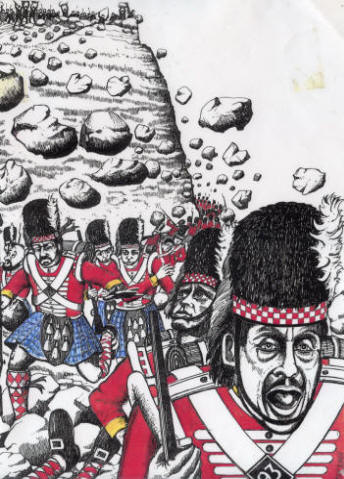 |
|
|
|
The Merthyr
Tydfil rioters bathed their flag in calf's blood to
create a symbol of common suffering and of equality of
humankind...to be raised together with a loaf of bread.
This was the first time the red flag of revolution came
to be flown. |
|
Dafydd Lewis
headed the Cefn Coed rioters that intercepted the 93rd
Highlanders on their way from Brecon Barracks to Merthyr
Tydfil. They made energetic use of the loose boulders
that abound on the slopes of Y Ddarren Fawr - Nr Cefn
Coed. |
|
|
|
|
|
|
|
|
 |
|
|
|
|
|
|
|
Richard Lewis lived
in Ynysfach.
Where the Merthyr
College of Further Education now stands. |
|
Merthyr
High Street. |
|
|
|
 |
|
 |
|
|
|
|
|
|
|
|
|
|
The old
Castle Hotel |
|
|
|
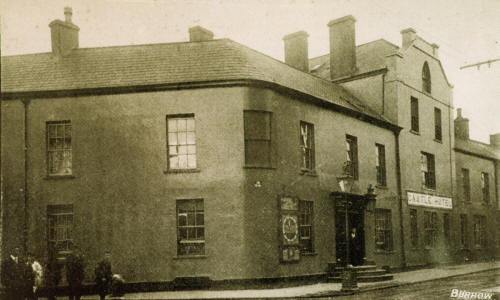 |
|
|
|
|
|
|
|
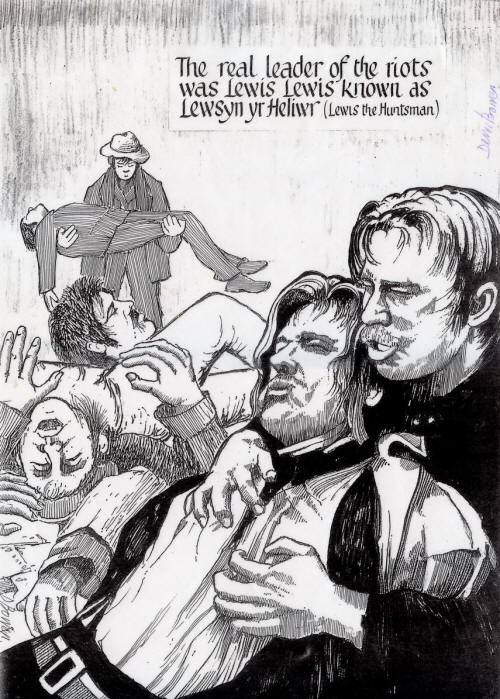 |
|
|
|
24 men, women and
children were killed and 74 injured in the Merthyr riots - June
1831 |
|
|
|
|
|
|
|
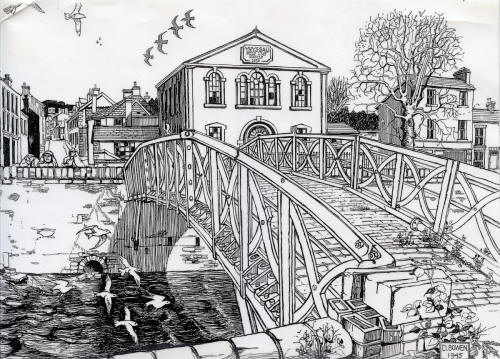 |
|
|
|
The Iron Bridge -
Ynysgau - near the home of Richard Lewis |
|
|
|
|
|
|
|
It took a week for the forces of the Crown to finally bring
order to the area. Punishment was severe: Lewis Lewis, after
first receiving the death sentence, was exiled for life and
Richard Lewis, known as Dic Penderyn, was executed on a
charge of wounding a highlander. On 31 July, 1831, he was hanged
in Cardiff Gaol, despite the appeal of many thousands of people
for his life. Forty years later, leuan Parker of Cwmafan, a
Welshman living in the United States confessed to the charge.
Lewis thus became a martyr of the Welsh working class. A popular
ballad of the time ran:
I saw the Merthyr riots, And the great oppression of the
workers; And some of the soldiers wounded... But dear heaven!
the worst trick Was the hanging of Die Penderyn.
It is recorded that the last words spoken by Richard Lewis on
the scaffold were "O Arglwydd, dyma gamwedd" (Oh Lord, what an
injustice).
The martyrdom of Richard Lewis is .well remembered in Wales, but
in England there seems to have been general indifference, as
pointed out by an entry in the diary of a Mrs. Arbuthnot in
June, 1831:
There has been a great riot in Wales and
the soldiers have killed twenty-four
people. When two or three were killed at
Manchester, it was called the Peterloo
Massacre and the newspapers for weeks
wrote it up as the most outrageous and
wicked proceeding ever heard of. But that
was in Tory times; now this Welsh riot is
scarcely
mentioned.
In Parliament, Lord Melbourne, who had advocated severe
repression of all popular workers' movements as
"unlawful assemblages of armed individuals," declared that South
Wales was "the worst and most formidable district in the
kingdom." He wrote to a friend that "The affair we had there in
1831 was the most like a fight of anything that took place." |
|
|
|
|
|
|
|
SENTENCED TO DEATH |
|
|
|
|
|
|
|
 |
|
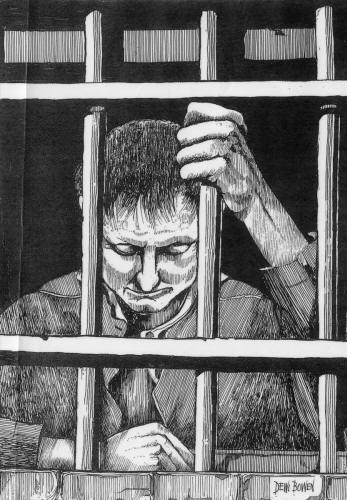 |
|
|
|
Richard Lewis
was accused of wounding a soldier of the crown. He
protested his innocence to the end. |
|
Richard Lewis
in the condemned cell. |
|
|
|
|
|
|
|
|
|
|
|
|
|
|
|
|
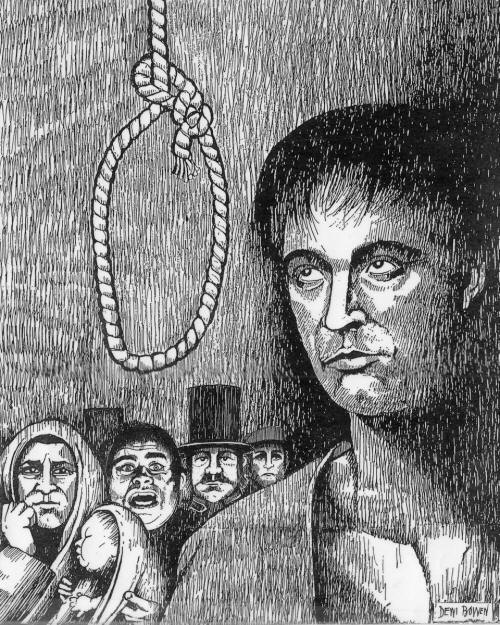 |
|
|
|
O ARGLWYD DYMA GAMWEDD !
O LORD WHAT AN INJUSTICE ! |
|
|
|
Richard Lewis was
25 years of when he went to the gallows at the former Cardiff
County Jail on - Friday August 13th 1831. |
|
|
|
|
|
|
|
The site of the old
Cardiff Jail in Castle Street opposite the Castle.
(Photograph courtesy of
Robert O'Keefe Video Services) |
|
|
|
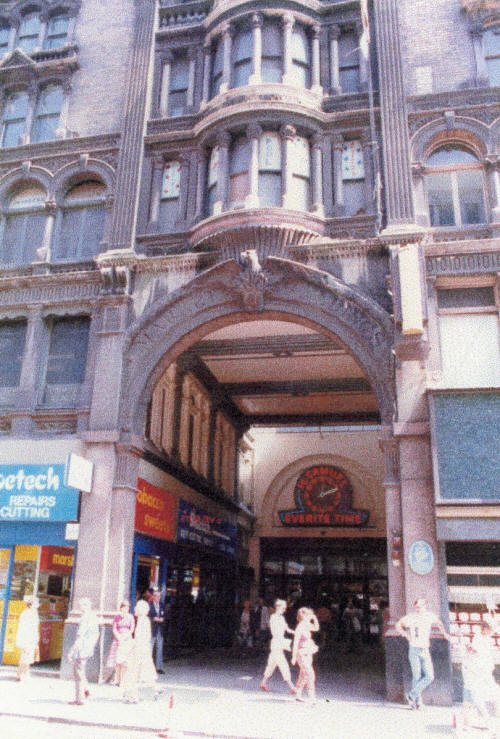 |
|
|
|
Site of the County
Jail. Dic Penderyn (Richard Lewis) aged 23 was hanged on this
site, at 8am on Friday 13th of August 1831. The County Jail
stood on this site for 300 years, and it was the scene of brutal
punishment and religous and political martyrdoms. |
|
|
|
|
|
|
|
DeathCertificate_14-_small.jpg) |
|
|
|
This
is the entry recording the death of Richard Lewis (Dic
Penderyn). It is unusual for a member of the clergy to make an
extra entry in the register. The entry reads:
"The
above unfortunate man was execute at Cardiff on the 13th August
1831, for stabbing Donald Black, one of the 93rd Highlanders
while stationed on duty at Merthyr during the riots on the 3rd
of June last. He was indicted under 9 geo.JV. |
|
|
|
|
|
|
|
St. Mary's
Church, Aberavon.
Where Richard
Lewis is buried.
(Photograph courtesy of
Robert O'Keefe Video Services) |
|
The Grave
of Richard Lewis (Dic Penderyn).
(Photograph courtesy of
Robert O'Keefe Video Services) |
|
| |
 |
|
 |
|
| |
|
|
|
|
| |
Thanks to Mr Dewi Bowen for allowing
the use of his wonderful drawings. |
|
|
|
|
|
|
|
|
|
|
Dic Penderyn
Dic, Dic, Oh, Dic Penderyn
An
innocent man died while hanging.
A young man of
twenty-three
His spirit should now be free. A murder that cost him
his life in 1831, a pardon now and
history is done.
Ciara Devoy Age
8
Ysgol Santes Tudful |
|
Dic Penderyn
Dic Penderyn will be honoured this year
For sacrificing his life,
He stood for his rights as a working man
where
poor conditions were rife.
There were protests and riots and many affrays
to
make people pay some attention To the plea of the men
from the ironworks
and
this was their only intention.
But, the sad story is - as the riots took place
That an innocent man was attacked,
And Dic Penderyn was blamed for this assault
On the victim called Donald Black.
It came to pass W years on,
that he was cleared of the tragic bloodshed by
the confession of leuan Parker -
A man who was lying on his deathbed.
Rachel Mehegan Age 9
Ysgol Santes Tudful
|
|
|
|
|
|
|
|
|
|
Dic Penderyn
Why did he die?
Because he injured Donald Black
But he did not injure Donald Black
Why did he die?
Why did he die?
He did not injure Donald Black
But leuan Parker did
Why did he die?
Why did he die?
He pleaded guilty
And was executed for a crime
He did not
commit
Why did he die?
Rhys
Jones Age 9
Ysgol
Santes Tudful
|
|
Dic Penderyn
Rebel o Aberafcm oedd Die Penderyn,
A gafodd fywyd caled Aeth i Ferthyr er mwyn cael gwaith
A hefyd i lenwi ei waled!
Gweithiwr
yn y gweithfeydd haearn oedd Die
Ond aeth ar streic un
diwrnod, Doedd neb yn hapus gyda'r amodau gwaith,
Ac nid oedd pawb mewn
undod.
Mewn amser fe aeth y gweithwyr Yn erbyn y rheolwyr yn
llu,
Anafwyd un o'r enw Donald Black A oedd yn filwr o fri.
Die gafodd y bai o'i anafu
A chrogwyd yntau yng Nghaerdydd,
Flynyddoedd wedyn cyfaddefodd leuan Parker
Ond i Die roedd hi'n rhy hwyr yn y dydd.
Dewi Emlyn Griffiths Oedran 8
Ysgol Santes Tudful
|
|
|
|
|
|
|
|
|
|
I am Richard Lewis - Dic Penderyn
They are going to hang me. They said I wounded a
soldier in the Uprising -
I didn't do it, God.
Oh yes, I joined the demonstration of the
Radicals,
I was in favour of Parliamentary Reform,
I helped them burn the books
Of the Court of Requests - and Joseph Coffin's
furniture;
I marched from home to home
Retrieving goods seized by the Court,
I heard them read the Riot Act
In English and in Welsh;
I stood with the crowd at the Castle Inn,
I shouted, Cheese with bread! with the rest,
I saw the crowd attack,
The blood - the dead - the dying,
But I didn't join in the fight -
Wound a soldier?
I didn't do it, God,
I only cheered.
The injured soldier, Donald Black,
Said he saw me raise my hat and cheer
But not cause harm to anyone.
But Lord Melbourne refused to grant reprieve.
I am to leave my cell in Cardiff gaol
On August 13th, 1831, to die on the gallows.
You know all things, God,
You know my innocence -but -
They won't believe my cry -
I didn't do it, God -O
Arglwydd, dyma gamwedd –
O Lord, what an iniquity!
Gwyneth E Evans
Hampton Street, Twynyrodyn.
|
|
|
|
|
|
|
|
|
|
|
|
|
|
|